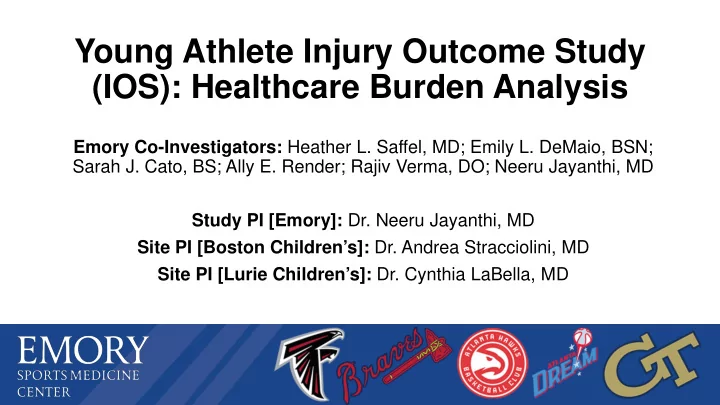

Young Athlete Injury Outcome Study (IOS): Healthcare Burden Analysis Emory Co-Investigators: Heather L. Saffel, MD; Emily L. DeMaio, BSN; Sarah J. Cato, BS; Ally E. Render; Rajiv Verma, DO; Neeru Jayanthi, MD Study PI [Emory]: Dr. Neeru Jayanthi, MD Site PI [Boston Children’s]: Dr. Andrea Stracciolini, MD Site PI [Lurie Children’s]: Dr. Cynthia LaBella, MD
Disclosures I, Heather Saffel, have no relevant disclosures.
Grant Funding • Emory University Department of Orthopaedics (2018) • Seed Grant ($2,500) • American Medical Society for Sports Medicine (2019) • Foundation Grant ($20,900)
Background: Why do we care?
Background: Previous Studies • Acute injuries • 571 sports injuries in 1 year • 28 sports • 65% males • 1.9 visits per injury • Mean cost per injury $446 • Individual sports more costly
Background: Previous Studies • 12 million athletes ages 5-22 suffer sport-associated injury annually • $33 billion in health care costs
Background: Previous Studies • 72 of 82 Belgium sports federations participated • Main outcome: total direct and indirect medical cost on healthcare budget • Highest direct medical cost ACL (1358 euros) • Lowest for foot injuries (52 euros)
Background: Previous Studies • 119 injuries in 104 children over 1 year • Sports v leisure time v PE • Mean direct cost 131 +/- 213 euros • Highest costs in upper extremity and leisure time activities
Background: Gap in Research • Healthcare burden based on TYPE of injury in youth Overuse Concussion Acute
Purpose • To determine if the effect of sport related injury on healthcare burden varies by injury type (acute, overuse, concussion) in a clinical cohort of young athletes over 3 years.
Methods & Study Design • Cross-sectional longitudinal clinical cohort study • Data collected 2018-2019 (planning for 3 yrs) • 3 cohorts: acute, overuse, or concussion • Ages 8-18 at time of enrollment • Information gathered from EMR 6 months from time of enrollment • Data included age, gender, # of clinic visits, x-rays, MRIs, & surgeries
Methods & Study Design EMR Data Collection Survey Data Collection
Demographics: Emory Only • Total # consented eligible at 6 months from enrollment: 233 subjets • Males: 141 (61%) • Females: 92 (39%) • Avg age: 15 yo Gender & injury type Gender Acute Concussion Overuse Male 70 /105 (67%) 15 /32 (47%) 56 /96 (58%) Female 35 /105 (33%) 17 /32 (53%) 40 /96 (42%)
Preliminary Data: Emory Only Total visits within 6 months of enrollment by injury type Injury Type Kruskal-Wallis Test N Median Mean Std Dev Minimum Maximum P value Acute 105 3 2 2 1 9 0.29 144 (92.9%) Concussion 32 3 3 2 1 9 Overuse 96 3 2 2 1 13 Sports medicine visits within 6 months of enrollment by injury type Injury Type Kruskal-Wallis Test N Median Mean Std Dev Minimum Maximum P value Acute 105 2 2 2 1 9 0.10 Concussion 32 3 3 2 1 9 Overuse 96 2 3 2 1 13 The statistical power is low to detect a difference of this size
29 (20%) Preliminary Data: Emory Only 23 (15.9%) Number of X-rays within 6 months of enrollment by injury type Injury Type Kruskal-Wallis Test N Mean Minimum Maximum P value Acute 105 2 0 6 <.0001 Concussion 32 0 0 1 Overuse 96 1 0 6 Pairwise P values (Wilcoxon rank-sum test): Acute vs Concussion: P <.0001 Overuse vs Concussion: P <.0001 Acute vs Overuse: p= 0.0010
Preliminary Data: Emory Only Rates of MRI tests per 1000 patients by injury type Acute Concussion Overuse 144 (92.9%) Yes MRIs 24/105 (22%) 0/32 (0%) 47/96 (49%) 69 (47.6%) (>=1 ) 229 MRIs per 1000 patients 0 MRIs per 1000 patients 490 MRIs for 1000 patients (95% CI: 146,340) (95% CI: 0,115) (95% CI: 360,651) 76 (52.4%) Rates were used to summarize the data due to the high number of zeros 95% confidence intervals do not overlap indicating the rates are different by injury type
Preliminary Data: Emory Only # of surgeries by injury type # of surgeries Acute Concussion Overuse 0 92/105 (87.62%) 32/32 (100%) 90/96 (93.75%) 1 13/105 (12.4%) 0/32 (0%) 5/96 (5.2%) 2 0/105 (0%) 0/32 (0%) 1/96 (1%) Pairwise Fisher’s exact P value: Acute vs Concussion: P=0.04 Overuse vs Concussion: P =0.50 Acute vs Overuse p= 0.06
Preliminary Conclusions At 6 months post-enrollment: 1. There is no difference in number of clinic visits by injury type. 2. The rate of MRI per 1000 patients is different by injury type (overuse>acute>concussion). 3. There are pairwise differences in the number of surgeries by injury type (acute>concussion, acute>overuse). 4. There are pairwise differences in the median number of x-rays by injury type (acute>concussion, overuse>concussion, acute>overuse).
Limitations • Analysis presented is preliminary data • Risk for sampling bias • Unable to capture outside resources used • Cross sectional data and not yet longitudinal
Clinical Significance • Injury type affects rate of MRIs & surgeries in young athlete, but not number of clinic visits. • Acute injuries require more surgeries. • Overuse injuries require more MRIs. • Longitudinal data on healthcare burden by injury type may help guide counseling young athletes & families on potential healthcare burden of each injury.
Questions?/Discussion
Recommend
More recommend